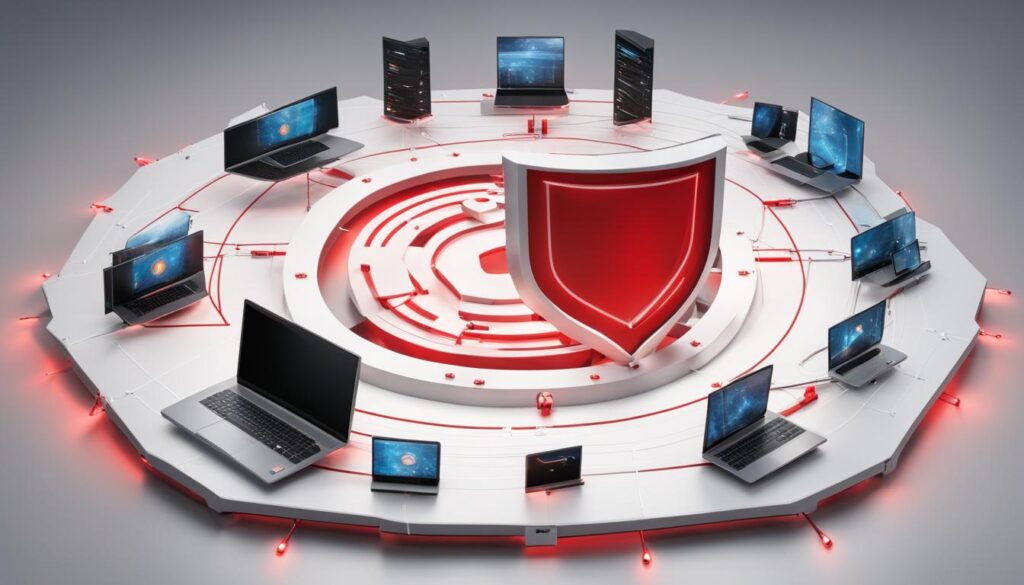Welcome to our article on Trellix Endpoint Security, the cutting-edge solution for advanced endpoint protection. In today’s digital landscape, organizations face increasingly sophisticated cyber threats that can infiltrate networks through various endpoints.
Trellix Endpoint Security provides unparalleled defense against advanced threats by leveraging machine learning and behavioral analysis. By analyzing patterns and behaviors, it can identify and block threats such as fileless, script-based, and zero-day attacks. Unlike traditional security tools, Trellix goes beyond reactive measures, proactively identifying potential new or complex threats to keep your endpoints safeguarded.
With its advanced threat research team, Trellix stays one step ahead, uncovering and reporting nearly 400,000 new types of attacks every day. This constant analysis and vigilance ensure that your organization is protected against the latest and most dangerous threats.
Key Takeaways:
- Trellix Endpoint Security uses machine learning and behavioral analysis to detect and block advanced threats.
- It goes beyond traditional security tools by proactively identifying potential new or complex threats.
- Trellix’s threat research team reports nearly 400,000 new types of attacks every day.
- With Trellix, organizations can stay ahead of evolving threats and protect their digital assets.
- Implementing Trellix Endpoint Security provides comprehensive and proactive security for your endpoints.
What is Endpoint Security?
Endpoint security plays a crucial role in safeguarding the entry points of end-user devices, including desktops, laptops, and mobile devices, against malicious actors and cyber threats. It encompasses a variety of security applications designed to protect endpoints from malware infections and cyber attacks.
By implementing robust endpoint security measures, organizations can fortify their network security solutions and ensure the integrity of their sensitive data. This proactive approach shields endpoints from potential vulnerabilities, preventing unauthorized access and preserving the confidentiality, availability, and integrity of critical information.
Endpoint security is an essential component of a comprehensive cybersecurity strategy, providing the necessary defenses to counter the evolving threat landscape. With the growing complexity of cyber threats, organizations must prioritize endpoint security to mitigate risks and protect their digital assets.
Endpoint security solutions employ advanced technologies and practices to secure end-user devices. These measures often include:
- Antivirus and Antimalware: Endpoint security solutions utilize antivirus and antimalware software to detect and remove malicious software, ensuring the safety of endpoints.
- Firewalls: Firewalls act as a barrier between a trusted internal network and external networks, monitoring and controlling network traffic to prevent unauthorized access.
- Encryption: Endpoint encryption encrypts data stored on endpoints, rendering it unreadable to unauthorized individuals.
- Application Control: Application control restricts the execution of unauthorized applications, preventing the installation of malicious software.
- Patch Management: Patch management ensures that endpoints are up to date with the latest security patches, minimizing vulnerabilities.
Implementing endpoint security not only safeguards individual devices but also strengthens the overall security posture of organizations. By protecting endpoints, businesses can minimize the risk of data breaches, financial losses, and reputational damage arising from cyber incidents.
Key Features of Endpoint Security
The following table highlights some key features of endpoint security:
| Feature | Description |
|---|---|
| Real-time Threat Detection | Continuous monitoring and detection of potential threats in real time. |
| Behavioral Analysis | Identifying abnormal behaviors and activities on endpoints, indicating potential threats. |
| Device Control | Enforcing policies to regulate the use of external devices and prevent data leakage. |
| Data Loss Prevention | Detecting and preventing the unauthorized transfer or disclosure of sensitive data. |
| Web Protection | Blocking access to malicious websites and preventing web-based threats. |
| Centralized Management | Centrally managing and monitoring endpoint security across the organization. |
How does advanced endpoint protection work?
Advanced endpoint protection utilizes cutting-edge technologies such as machine learning and security analytics to provide robust security against evolving threats. Let’s take a closer look at how these components work together to safeguard endpoints.
Machine Learning: Identifying Typical Behaviors
Machine learning algorithms analyze vast amounts of data from endpoints to identify patterns and behaviors that are indicative of potential threats. By understanding what constitutes normal behavior, the system can detect anomalous activities that may signify a cyberattack. This constant analysis of endpoint behavior helps to create a baseline of normal activities.
When deviations from this baseline occur, advanced endpoint protection solutions can generate alerts to notify IT staff or trigger automatic security processes, ensuring that potential threats are swiftly identified and addressed.
Security Analytics: Detecting Potential Threats and Investigating Breaches
Security analytics tools play a crucial role in the advanced endpoint protection ecosystem. These tools record and analyze data from endpoints, including network traffic, system logs, and user behavior, to detect potential threats.
Through comprehensive analysis and correlation of data, security analytics tools can identify patterns and indicators that might otherwise go unnoticed. This proactive approach enables organizations to stay one step ahead of cybercriminals. In the event of a security breach, security analytics aids in the investigation process by providing detailed insights and actionable intelligence for incident response and mitigation.
“The combination of machine learning and security analytics forms a powerful defense against advanced threats. By applying these technologies, advanced endpoint protection greatly enhances an organization’s ability to detect and prevent potential cyberattacks.”
By leveraging the capabilities of machine learning and security analytics, organizations can benefit from advanced endpoint protection that proactively defends against a wide range of threats. This multifaceted approach to cybersecurity helps identify and neutralize sophisticated attacks that traditional security solutions might struggle to detect.
Next, let’s explore the benefits that advanced endpoint protection brings and how it can bolster an organization’s overall cybersecurity posture.
| Benefits of Advanced Endpoint Protection |
|---|
| 1. Proactive defense against advanced threats |
| 2. Protection against blended attacks and zero-day threats |
| 3. Real-time threat intelligence integration |
| 4. Faster threat containment and response |

Benefits of Advanced Endpoint Protection
Advanced endpoint protection offers numerous benefits to organizations in their quest for enhanced cybersecurity solutions. By leveraging advanced defense mechanisms, this innovative approach provides a higher level of protection against the ever-evolving threat landscape.
Protection against Blended Attacks and Zero-Day Threats
Traditional security systems often struggle to identify and combat blended attacks and zero-day threats effectively. However, advanced endpoint protection utilizes cutting-edge technologies such as machine learning and behavioral analysis to proactively detect and mitigate these sophisticated threats. By analyzing patterns and behaviors, it can identify malicious activities that may bypass traditional security tools, preventing potential data breaches and system compromise.
“Advanced endpoint protection goes beyond static signatures and known threats, offering organizations a vital layer of defense against increasingly complex and dynamic cyber threats.”
Real-Time Threat Intelligence
One of the significant advantages of advanced endpoint protection is its ability to provide real-time threat intelligence. By continuously monitoring external sources, threat intelligence feeds deliver up-to-date information on emerging threats and attack vectors. This real-time information empowers organizations to respond rapidly and effectively, reducing the time from the first encounter with a threat to containment and mitigation.
Improved Threat Detection and Response
By leveraging advanced technologies and analytics, advanced endpoint protection significantly enhances threat detection and response capabilities. Its robust defense mechanisms, including machine learning algorithms and security analytics, enable the identification of malicious activities and the prompt initiation of remedial actions. This proactive approach ensures that organizations stay one step ahead of cyber threats and minimize the potential damage caused by successful attacks.
Furthermore, advanced endpoint protection integrates seamlessly with existing security infrastructure, providing valuable insights and enabling coordinated defenses. This integration enhances the overall security posture and facilitates a more efficient and effective incident response process.
The Power of Advanced Endpoint Protection
Organizations that embrace advanced endpoint protection benefit from heightened security and peace of mind. By countering blended attacks, zero-day threats, and unknown malware, it ensures the safety of critical data and network endpoints. Real-time threat intelligence and improved detection capabilities further bolster an organization’s ability to protect against emerging threats and respond swiftly when necessary.
With advanced endpoint protection, organizations can safeguard their digital assets and maintain a robust cybersecurity posture in the face of an ever-evolving threat landscape.

| Benefits of Advanced Endpoint Protection |
|---|
| Protection against blended attacks and zero-day threats |
| Real-time threat intelligence |
| Improved threat detection and response |
What is Endpoint Management?
Endpoint management plays a crucial role in ensuring the security and smooth functioning of an organization’s IT infrastructure. It involves authenticating and supervising the access rights of endpoint devices, such as desktops, laptops, and mobile devices, to a network. Endpoint management also encompasses the implementation of essential security policies to safeguard these devices from potential threats.
With the increasing number of endpoints connected to networks, including remote devices and IoT devices, endpoint management has become vital for organizations to maintain a secure environment. By centralizing the management of endpoint security, organizations can efficiently enforce security protocols and prevent unauthorized access.
Effective endpoint management enables IT teams to monitor and control the security posture of individual devices, ensuring that they comply with security policies. It also allows for the timely deployment of critical security updates and patches, reducing vulnerability to cyberattacks.
An essential component of endpoint management is the ability to define and manage user access rights. By authenticating and authorizing users, organizations can ensure that only authorized individuals have access to sensitive data and resources. Endpoint management also enables the enforcement of security policies, such as data encryption, password complexity, and network access controls.
Benefits of Endpoint Management:
- Enhanced Security: Endpoint management helps organizations maintain a robust security posture by enforcing security policies and keeping endpoints up to date with the latest security patches.
- Improved Efficiency: Centralized management of endpoints streamlines IT operations, allowing for efficient monitoring, troubleshooting, and maintenance tasks.
- Increased Productivity: By ensuring the availability and proper functioning of endpoint devices, organizations can minimize downtime and optimize workforce productivity.
- Compliance Management: Endpoint management facilitates compliance with industry regulations and data protection standards by implementing security controls and enforcing policy adherence.
Endpoint management plays a crucial role in the overall IT security services landscape. It enables organizations to effectively manage and secure their endpoints, mitigating potential risks and maintaining a strong defense against cyber threats.
What is Endpoint Encryption?
Endpoint encryption plays a crucial role in safeguarding sensitive data and protecting against data breaches. This process involves encoding or scrambling data in a way that can only be deciphered with the correct decryption key. By rendering data unreadable to unauthorized individuals, endpoint encryption provides an extra layer of security, ensuring that confidential information remains protected on endpoints.
Why Endpoint Encryption is Essential
Endpoint encryption is a fundamental component of data protection services, as it prevents unauthorized access to valuable information stored on devices. Whether it’s financial records, customer data, or intellectual property, encrypting data at the endpoint helps mitigate the risk of unauthorized disclosures and data breaches. It ensures the confidentiality and integrity of sensitive information, putting organizations in control of their data security.
The Benefits of Endpoint Encryption
Endpoint encryption offers several advantages in terms of data protection, compliance, and risk management. Some key benefits include:
- Data Confidentiality: Encrypting data on endpoints ensures that even if a device is lost, stolen, or compromised, the sensitive information remains inaccessible to unauthorized parties.
- Regulatory Compliance: Endpoint encryption helps organizations comply with various data privacy regulations and industry standards, such as GDPR, HIPAA, and PCI DSS.
- Risk Mitigation: By implementing robust encryption measures, organizations reduce the risk of data breaches and the associated financial, reputational, and legal consequences.
- Trust and Reputation: Demonstrating a commitment to data security through endpoint encryption enhances customer trust and strengthens the organization’s reputation.
Implementing Endpoint Encryption
Organizations can deploy different encryption solutions to protect endpoint data. Depending on their specific needs and requirements, they can choose from various technologies, including:
- Full Disk Encryption (FDE): Encrypts the entire hard drive of the device, offering complete protection for all data stored on the endpoint.
- File-Level Encryption: Encrypts individual files, folders, or documents, allowing organizations to selectively secure specific sensitive information.
- Endpoint Security Platforms: These comprehensive solutions provide encryption capabilities alongside other security features, such as antivirus, firewall, and data loss prevention.
Ultimately, endpoint encryption forms a critical part of an organization’s overall data protection strategy, ensuring the security and confidentiality of sensitive information on endpoints.
“Endpoint encryption adds an extra layer of security to protect sensitive data, mitigating the risk of unauthorized access and data breaches.”

What is Managed Detection and Response?
Managed Detection and Response (MDR) is an outsourced cybersecurity service that offers comprehensive protection for data and assets, even against threats that can bypass common security controls. MDR combines proactive threat detection and response capabilities to help organizations defend against advanced cybersecurity threats.
With managed detection and response, organizations can leverage the expertise of a dedicated team of cybersecurity professionals who are equipped with advanced tools and technologies. These professionals continuously monitor and analyze network traffic, endpoints, and security events to detect and respond to potential threats in real time.
Powered by cutting-edge technologies and security best practices, MDR provides:
- 24/7 Monitoring: Constant monitoring of network and endpoint activity to identify and respond to potential threats.
- Threat Hunting: Proactive searching for indicators of compromise and potential security breaches.
- Incident Response: Rapid response and mitigation in the event of a cyber incident or breach.
- Forensic Analysis: In-depth investigation to understand the root cause of security incidents and prevent future occurrences.
- Threat Intelligence: Access to up-to-date threat intelligence to stay ahead of evolving threats.
- Compliance Support: Assistance in meeting regulatory requirements and maintaining a strong security posture.
By outsourcing their cybersecurity needs to a managed detection and response service provider, organizations can enhance their security infrastructure without the need for additional resources or expertise. MDR offers a cost-effective and scalable solution, enabling organizations to focus on their core business activities while benefiting from advanced threat detection and response capabilities.

With MDR, organizations gain peace of mind knowing that their critical assets and sensitive data are protected against advanced threats. This proactive approach to cybersecurity helps organizations stay one step ahead of cybercriminals and ensures a strong defense against evolving cyber threats.
Benefits of Managed Detection and Response:
“Managed Detection and Response provides organizations with:
- Proactive Threat Detection: Continuous monitoring and analysis of network and endpoint activity to detect threats before they cause damage.
- Rapid Incident Response: Immediate response and mitigation in the event of a security incident or breach.
- 24/7 Security Monitoring: Continuous monitoring of security events to ensure timely threat detection and response.
- Expert Support: Access to a team of skilled cybersecurity professionals with expertise in threat detection and response.
- Cost-Effectiveness: Outsourcing cybersecurity to a managed service provider eliminates the need for extensive in-house resources and expertise.
- Compliance Assistance: Support in meeting regulatory requirements and maintaining a strong security posture.
Managed detection and response is a vital component of a comprehensive cybersecurity strategy, providing organizations with the necessary tools and expertise to defend against advanced threats. By combining advanced technologies, round-the-clock monitoring, and expert support, MDR helps organizations stay resilient in the face of evolving cybersecurity challenges.
What is Next-Gen Endpoint Security?
Next-gen endpoint security is a cutting-edge approach that harnesses the power of modern artificial intelligence and machine learning to deliver comprehensive and adaptive protection. By integrating network and device security, next-gen endpoint security offers more effective defenses compared to traditional endpoint security solutions. This advanced security solution leverages cloud-based security to monitor and respond to new and emerging threats in real time.
Next-gen endpoint security combines multiple layers of protection to safeguard endpoints from a wide range of cyber threats. It utilizes behavioral analysis and advanced threat intelligence to proactively detect and block malicious activities. The integration with cloud-based security enables quick identification and response to evolving threats, ensuring organizations stay one step ahead of attackers.
With next-gen endpoint security, organizations can benefit from:
- Advanced threat detection: The advanced analytics capabilities of next-gen endpoint security enable the detection of sophisticated threats, including zero-day attacks and fileless malware.
- Adaptive protection: By continuously analyzing endpoint behavior and applying machine learning algorithms, next-gen security solutions adapt and evolve to counter new and evolving threats.
- Cloud-based monitoring: Leveraging cloud-based security enables real-time monitoring, analysis, and response to threats across all endpoints, providing a centralized view of endpoint security posture.
Next-gen endpoint security empowers organizations to tackle the rapidly evolving threat landscape and protect their valuable data and assets from advanced and persistent cyberattacks.
The Benefits of Next-Gen Endpoint Security:
| Benefits | Description |
|---|---|
| Comprehensive protection | Next-gen endpoint security offers a multi-layered approach to protect endpoints from a wide range of threats, providing a holistic defense strategy. |
| Real-time threat detection | The advanced analytics capabilities enable the detection of threats in real time, allowing organizations to quickly respond and prevent potential damages. |
| Adaptive defenses | Next-gen security solutions adapt and learn from evolving threats, constantly improving their ability to identify and block new attack patterns. |
| Centralized management | Cloud-based monitoring and management provide a centralized view of endpoint security, simplifying administration and enhancing visibility. |

By implementing next-gen endpoint security, organizations can strengthen their overall security posture and mitigate the risks associated with advanced cyber threats. The combination of artificial intelligence, machine learning, and cloud-based security empowers organizations to effectively protect their endpoints from the ever-evolving landscape of cyber threats.
Endpoint Protection Platform: Essential Security for All Endpoints
In today’s interconnected world, organizations need robust security measures to protect their endpoints from evolving cyber threats. An Endpoint Protection Platform (EPP) offers a comprehensive suite of technologies designed to safeguard various types of endpoints, including smartphones, laptops, desktops, servers, and even printers. By centralizing endpoint security, EPPs simplify the management of security protocols and ensure consistent protection across the entire network.
EPPs go beyond traditional antivirus software, providing advanced defense mechanisms to detect and thwart emerging threats. One of the key features of an EPP is security analytics, which enables organizations to proactively identify and investigate potential security incidents. By analyzing endpoint data, security analytics can detect anomalies, suspicious activities, and signs of unauthorized access, allowing for prompt remediation and preventing potential breaches.
Take a look at the table below to understand the core capabilities of an Endpoint Protection Platform:
| Key Features | Description |
|---|---|
| Real-time threat detection | Continuous monitoring and immediate identification of potential threats. |
| Behavior-based analysis | Identification of unusual behaviors or patterns that may indicate malicious activity. |
| Malware prevention | Blocking and removing known malware, including viruses, worms, and ransomware. |
| Patch management | Automated updates and vulnerability management for software and operating systems. |
| Endpoint encryption | Protecting sensitive data by encrypting it, rendering it unreadable to unauthorized users. |
| Centralized management | Unified console for streamlined administration and policy enforcement. |
An EPP provides organizations with a proactive defense against a wide range of security threats, including malware infections, zero-day exploits, and advanced persistent threats (APTs). By leveraging cutting-edge technologies and security analytics, EPPs empower organizations to stay one step ahead of cybercriminals and safeguard their valuable data and assets.

Don’t leave your endpoints vulnerable! Implementing an Endpoint Protection Platform is crucial in today’s threat landscape. By fortifying your network with advanced security measures, you can ensure the safety and integrity of your endpoints while mitigating the risks posed by sophisticated cyber attacks.
Trellix Endpoint Security Benefits
Trellix Endpoint Security offers advanced defenses against a wide range of advanced threats, providing organizations with robust protection for their endpoints. The key benefits of Trellix Endpoint Security include:
- Machine Learning: By leveraging machine learning technology, Trellix Endpoint Security can identify and block emerging threats in real-time. This proactive approach enhances threat detection and response capabilities.
- Credential Theft Defense: Trellix Endpoint Security includes advanced defenses against credential theft, a common attack vector. By safeguarding user credentials, it helps prevent unauthorized access to sensitive data and systems.
- Rollback Remediation: In the event of a security breach, Trellix Endpoint Security facilitates rollback remediation, allowing organizations to revert to a previous secure state. This feature helps mitigate the impact of security incidents and minimize downtime.
- Unified Policy and Console: Trellix Endpoint Security eliminates the need for multiple complex security tools by offering a unified policy and console. This centralized management approach streamlines security operations, making it easier for organizations to deploy and manage Trellix technologies.
- Actionable Threat Intelligence: The solution provides actionable threat intelligence and prioritized threat information, empowering organizations to make informed decisions and prioritize their response efforts. This enhances overall threat detection and response capabilities.
“Trellix Endpoint Security offers advanced defenses against emerging threats, with machine learning, credential theft defense, and rollback remediation capabilities.”
In summary, Trellix Endpoint Security delivers comprehensive protection for endpoints, combining advanced threat detection and response features. With its advanced capabilities, organizations can effectively defend against evolving threats and safeguard their digital assets.
Trellix Endpoint Security Features
Trellix Endpoint Security offers a comprehensive suite of advanced features to enhance your organization’s IT security services. With proactive threat defenses, automatic rollback remediation, real-time threat intelligence, and integration with Trellix Insights, you can fortify your endpoints and improve your security posture.
Let’s take a closer look at some key features of Trellix Endpoint Security:
- Proactive Threat Defenses: Trellix Endpoint Security utilizes cutting-edge technologies to proactively detect and block sophisticated threats. Machine learning algorithms analyze endpoint behavior patterns to identify potential threats in real time.
- Automatic Rollback Remediation: In the event of a successful breach, Trellix Endpoint Security automatically rolls back any unauthorized changes made to endpoints, minimizing the impact and restoring the system to a known secure state.
- Real-time Threat Intelligence: By leveraging real-time threat intelligence feeds, Trellix Endpoint Security keeps you updated on the latest threats and vulnerabilities. This enables proactive threat detection and response, ensuring your endpoints stay protected against emerging threats.
- Integration with Trellix Insights: Trellix Endpoint Security seamlessly integrates with Trellix Insights, providing a centralized platform for managing your security operations. This integration facilitates streamlined workflows, enabling efficient incident response and threat mitigation.
By harnessing the power of these features, Trellix Endpoint Security empowers your organization to detect, prevent, and respond to security threats effectively.
| Feature | Description |
|---|---|
| Proactive Threat Defenses | Utilizes machine learning algorithms to proactively detect and block sophisticated threats. |
| Automatic Rollback Remediation | Automatically rolls back unauthorized changes made to endpoints in the event of a successful breach. |
| Real-time Threat Intelligence | Leverages real-time threat intelligence feeds to keep you updated on the latest threats and vulnerabilities. |
| Integration with Trellix Insights | Seamlessly integrates with Trellix Insights for centralized security operations management. |
Trellix Endpoint Security and Intelligent Endpoint Protection
Trellix Endpoint Security offers advanced protection by sharing real-time observations and threat insights with other endpoint defenses. This collaborative approach accelerates the identification of suspicious behaviors and enhances protection against targeted attacks. By leveraging security analytics and threat intelligence, Trellix Endpoint Security provides organizations with intelligent defenses to improve threat detection and containment.
One of the key features of Trellix Endpoint Security is the Trellix Threat Intelligence Exchange, which allows for the exchange of real-time threat intelligence between endpoints. This enables faster identification and response to emerging threats, reducing the risk of a successful attack.
In addition, Trellix Endpoint Security utilizes the Trellix Global Threat Intelligence platform, which gathers threat information from various sources and provides comprehensive insights into the threat landscape. This global perspective enhances the effectiveness of threat detection and containment by offering a broader context for analysis.
Furthermore, Trellix Endpoint Security provides actionable threat forensics, allowing organizations to investigate and analyze security incidents. This helps in understanding the nature of the threats and provides valuable insights for future threat mitigation strategies.
The intelligent endpoint protection offered by Trellix Endpoint Security extends beyond individual defenses. It facilitates better coordination of defenses across the entire organization, ensuring a cohesive and unified security posture. By sharing threat insights and collaborating with other security solutions, Trellix Endpoint Security strengthens the overall security framework and provides comprehensive protection against advanced threats.
Benefits of Trellix Endpoint Security and Intelligent Endpoint Protection:
- Accelerated identification of suspicious behaviors
- Enhanced protection against targeted attacks
- Real-time threat intelligence exchange
- Comprehensive insights into the threat landscape
- Actionable threat forensics for investigation and analysis
- Better coordination of defenses across the organization
By leveraging security analytics, threat intelligence, and collaborative defenses, Trellix Endpoint Security provides organizations with a powerful and intelligent endpoint protection solution that mitigates risks and safeguards critical assets.
| Features | Description |
|---|---|
| Trellix Threat Intelligence Exchange | Enables real-time threat intelligence exchange between endpoints |
| Trellix Global Threat Intelligence | Gathers threat information from various sources for comprehensive insights |
| Actionable Threat Forensics | Provides valuable insights for investigating and analyzing security incidents |
| Better Coordination of Defenses | Facilitates collaboration and strengthens the overall security framework |
With Trellix Endpoint Security and its intelligent endpoint protection capabilities, organizations can stay one step ahead of evolving threats and ensure the security of their digital assets.
Conclusion
Trellix Endpoint Security is the ideal cybersecurity solution for organizations looking to protect their digital assets from a wide range of threats. With its comprehensive and proactive approach, Trellix Endpoint Security aligns with the priorities of modern enterprises, offering advanced threat detection, response, and prevention capabilities.
By leveraging cutting-edge technologies such as machine learning, behavioral analysis, and real-time threat intelligence, Trellix Endpoint Security ensures that organizations can stay one step ahead of evolving cyber threats. It provides a unified and centralized platform for managing and monitoring endpoint security, eliminating the complexity of managing multiple security tools.
With Trellix Endpoint Security, organizations can safeguard their endpoints from fileless, script-based, and zero-day threats, as well as identify and respond to potential new or complex attacks. The solution’s advanced defense mechanisms, like credential theft defense and rollback remediation, provide added layers of protection.
By choosing Trellix Endpoint Security, organizations can rest assured that their endpoints are secured with a powerful and reliable cybersecurity solution. With its holistic approach to endpoint security and commitment to staying ahead of emerging threats, Trellix Endpoint Security sets the bar high for comprehensive cybersecurity solutions.
FAQ
What is Trellix Endpoint Security?
Trellix Endpoint Security is a comprehensive security solution that provides advanced protection against various threats, including machine learning, credential theft defense, and rollback remediation. It offers a unified policy and console for managing Trellix technologies, actionable threat intelligence, and prioritized threat information for improved detection and response.
What is Endpoint Security?
Endpoint security involves securing entry points of end-user devices, such as desktops, laptops, and mobile devices, from being exploited by malicious actors and campaigns. It includes various security applications that protect endpoints from malware infections and cyberattacks.
How does advanced endpoint protection work?
Advanced endpoint protection uses machine learning and behavioral analysis to identify and block advanced threats, including fileless, script-based, and zero-day threats. It proactively identifies potential new or complex threats and goes beyond traditional security tools. Trellix’s threat research team reports nearly 400,000 new types of attacks every day.
What are the benefits of advanced endpoint protection?
Advanced endpoint protection provides advanced defense against a sophisticated threat environment. It helps protect against blended attacks and zero-day threats that traditional security systems may not easily identify. It also offers real-time threat intelligence to reduce the time from first encounter to threat containment.
What is Endpoint Management?
Endpoint management involves authenticating and supervising the access rights of endpoint devices to a network and applying security policies. It helps organizations ensure the security of their endpoints and manage IT security tasks effectively.
What is Endpoint Encryption?
Endpoint encryption is the process of encoding or scrambling data to make it unreadable without the correct decryption key. It helps protect sensitive data on endpoints and adds an extra layer of security to prevent data breaches.
What is Managed Detection and Response?
Managed Detection and Response (MDR) is an outsourced cybersecurity service that protects data and assets even if a threat evades common security controls. It provides proactive threat detection and response capabilities to help organizations defend against advanced threats.
What is Next-Gen Endpoint Security?
Next-gen endpoint security utilizes modern artificial intelligence and machine learning to provide comprehensive and adaptive protection. It integrates network and device security to offer more effective protection than traditional endpoint security solutions. It also leverages cloud-based security to monitor and act on new and emerging threats in real-time.
What is an Endpoint Protection Platform?
An Endpoint Protection Platform (EPP) is an integrated suite of endpoint protection technologies. It provides essential security for various types of endpoints, such as smartphones and printers. EPPs often include security analytics to detect and investigate potential threats.
What are the benefits of Trellix Endpoint Security?
Trellix Endpoint Security offers advanced threat detection, response, and prevention capabilities to protect endpoints from a wide range of threats. By combining machine learning, behavioral analysis, and real-time threat intelligence, it helps organizations stay ahead of evolving threats and secure their digital assets.
What features does Trellix Endpoint Security offer?
Trellix Endpoint Security provides proactive threat defenses, automatic rollback remediation, real-time threat intelligence, and integration with Trellix Insights. It offers centralized management with a choice of deployment options and provides advanced threat defenses like Dynamic Application Containment (DAC) and Real Protect.
How does Trellix Endpoint Security enhance intelligent endpoint protection?
Trellix Endpoint Security shares real-time observations and threat insights with other endpoint defenses, accelerating the identification of suspicious behaviors and enhancing protection against targeted attacks. It offers intelligent defenses like Trellix Threat Intelligence Exchange and Trellix Global Threat Intelligence to improve threat detection and containment.





